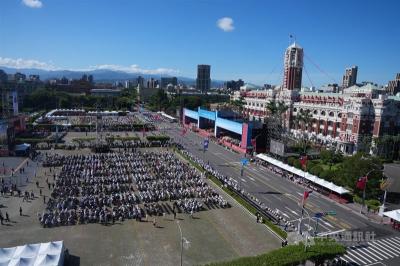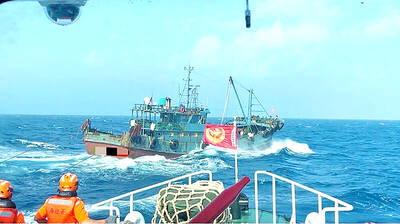Japan is to establish new military outposts on remote islands, a report said yesterday, as Tokyo looks to bolster its defense amid its territorial dispute with China.
Up to 350 troops each could be stationed on three islands in the far southwest, close to the Diaoyutai Islands (釣魚台), claimed by Taiwan, which Japan claims and calls the Senkakus and Beijing claims as the Diaoyu Archipelago (釣魚群島), the mass-selling Yomiuri Shimbun reported.
With the exception of Okinawa, Japan’s Ground Self-Defense Forces — its army — have no bases on the chain of islands that runs from the bottom of Kyushu to Taiwan. There are limited air force facilities in the area.
The lack of substantial military presence is a source of worry for some in Japan, who caution that it leaves Japan vulnerable to China’s increasingly assertive stance.
Chinese ships have repeatedly moved into the islands’ waters, since Tokyo nationalized some of them in September 2012, to confront Japanese vessels.
The islands lie about 2,000km southwest of Tokyo and about 200km from the north of Taiwan.
While most of the bickering has been between coastguards from both sides, observers say military ships are loitering over the horizon, with some warning of the risk of a confrontation.
Beijing has spent heavily on its military in recent years in a bid to develop a “blue water” navy that can project force far into the Pacific.
This means getting through what it calls the “first island chain,” including Japan’s southwestern islands and the northern Philippines.
Tokyo is planning to set up new outposts on three islands, including Amamioshima, about 150km south of the Senkakus, the Yomiuri said, citing unnamed senior Japanese Ministry of Defense officials.
Japanese Deputy Minister of Defense Ryota Takeda is to visit Amamioshima this week to look at establishing a joint research project with the island, it said.
Two other candidate sites for the new posts include Miyako Island and Ishigaki Island, about 210km southwest and 170km south respectively of the disputed islets.
These units are to be in addition to a radar surveillance unit on Yonaguni, where a groundbreaking ceremony was held last month.
Bolstering the defense of Japan’s southwestern islands “has an aspect of strengthening the Japan-US security alliance,” a senior defense official told the Yomiuri.
Japanese Chief Cabinet Secretary Yoshihide Suga said under a new defense program, Japan had already decided to enhance its military presence in the southwest and had been conducting research.
“At the moment, however, we have not decided on specific, concrete locations, such as those reported,” he told a press conference.

POLITICAL AGENDA: Beijing’s cross-strait Mid-Autumn Festival events are part of a ‘cultural united front’ aimed at promoting unification with Taiwan, academics said Local authorities in China have been inviting Taiwanese to participate in cross-strait Mid-Autumn Festival celebrations centered around ideals of “family and nation,” a move Taiwanese academics said politicizes the holiday to promote the idea of “one family” across the Taiwan Strait. Sources said that China’s Fujian Provincial Government is organizing about 20 cross-strait-themed events in cities including Quanzhou, Nanping, Sanming and Zhangzhou. In Zhangzhou, a festival scheduled for Wednesday is to showcase Minnan-language songs and budaixi (布袋戲) glove puppetry to highlight cultural similarities between Taiwan and the region. Elsewhere, Jiangsu Province is hosting more than 10 similar celebrations in Taizhou, Changzhou, Suzhou,

The Republic of China (ROC) is celebrating its 114th Double Ten National Day today, featuring military parades and a variety of performances and speeches in front of the Presidential Office in Taipei. The Taiwan Taiko Association opened the celebrations with a 100-drummer performance, including young percussionists. As per tradition, an air force Mirage 2000 fighter jet flew over the Presidential Office as a part of the performance. The Honor Guards of the ROC and its marching band also heralded in a military parade. Students from Taichung's Shin Min High School then followed with a colorful performance using floral imagery to represent Taiwan's alternate name

COGNITIVE WARFARE: Chinese fishing boats transmitting fake identification signals are meant to test Taiwan’s responses to different kinds of perceived incursions, a report said Chinese vessels are transmitting fake signals in Taiwan’s waters as a form of cognitive warfare, testing Taipei’s responses to various types of incursions, a report by the Institute for the Study of War said on Friday. Several Chinese fishing vessels transmitted fake automatic identification system (AIS) signals in Taiwan’s waters last month, with one mimicking a Russian warship and another impersonating a Chinese law enforcement vessel, the report said. Citing data from Starboard Maritime Intelligence, the report said that throughout August and last month, the Chinese fishing boat Minshiyu 06718 (閩獅漁06718) sailed through the Taiwan Strait while intermittently transmitting its own AIS

CHINESE INFILTRATION: Medical logistics is a lifeline during wartime and the reported CCP links of a major logistics company present a national security threat, an expert said The government would bolster its security check system to prevent China from infiltrating the nation’s medical cold chain, a national security official said yesterday. The official, who wished to stay anonymous, made the remarks after the Chinese-language magazine Mirror Media (鏡周刊) reported that Pharma Logistics (嘉里醫藥物流) is in charge of the medical logistics of about half of the nation’s major hospitals, including National Taiwan University Hospital and Taipei Veterans General Hospital. The company’s parent, Kerry TJ Logistics Co (嘉里大榮物流), is associated with the National Committee of the Chinese People’s Political Consultative Conference (CPPCC) and the Chinese People’s Liberation Army (PLA), the